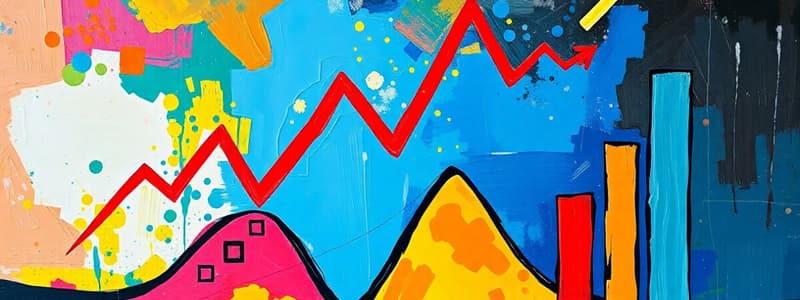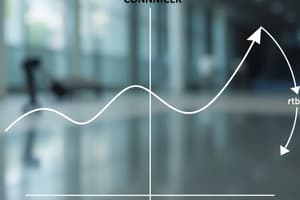Podcast
Questions and Answers
According to innovation theory, what is considered a fundamental cause of the business cycle?
According to innovation theory, what is considered a fundamental cause of the business cycle?
- Foreign investment
- Low consumer demand
- Innovation (correct)
- Excessive savings
Underconsumptionists believe that high savings can lead to economic growth.
Underconsumptionists believe that high savings can lead to economic growth.
False (B)
What happens if the Central Bank slows the growth of the money supply in the face of inflation?
What happens if the Central Bank slows the growth of the money supply in the face of inflation?
Recession will ensue.
Investment is stimulated as foreign credit is __________.
Investment is stimulated as foreign credit is __________.
Match the following concepts with their related definitions:
Match the following concepts with their related definitions:
What is characterized by a decline in total output, income, and employment?
What is characterized by a decline in total output, income, and employment?
What do underconsumptionists excessively consider in their theories?
What do underconsumptionists excessively consider in their theories?
Aggressive investment plans can support the sustainability of demand for goods.
Aggressive investment plans can support the sustainability of demand for goods.
The business cycle refers to fluctuations in economic activities that affect only a single industry.
The business cycle refers to fluctuations in economic activities that affect only a single industry.
What is innovation defined as in the context of economic theory?
What is innovation defined as in the context of economic theory?
What phase of the business cycle is referred to when economic activity is at its lowest?
What phase of the business cycle is referred to when economic activity is at its lowest?
In the expansion phase, income, output, trade, interest rates, wage, and employment are __________.
In the expansion phase, income, output, trade, interest rates, wage, and employment are __________.
Match the phases of the business cycle with their characteristics:
Match the phases of the business cycle with their characteristics:
Which statement best describes the Philippine economy in comparison to other countries?
Which statement best describes the Philippine economy in comparison to other countries?
Unemployment is typically low during the expansion phase of the business cycle.
Unemployment is typically low during the expansion phase of the business cycle.
How many notable economic cycles were identified starting from the beginning of 1997 in the text?
How many notable economic cycles were identified starting from the beginning of 1997 in the text?
What is headline inflation primarily concerned with?
What is headline inflation primarily concerned with?
Core inflation includes prices that have transitory effects.
Core inflation includes prices that have transitory effects.
What primary strategy do politicians use to stay in power according to the content?
What primary strategy do politicians use to stay in power according to the content?
When prices rise, producers are incentivized to produce more, while buyers suffer and will need more money in __________ terms.
When prices rise, producers are incentivized to produce more, while buyers suffer and will need more money in __________ terms.
Match the following commodities to their CPI weights:
Match the following commodities to their CPI weights:
Which type of inflation does the Bangko Central ng Pilipinas monitor?
Which type of inflation does the Bangko Central ng Pilipinas monitor?
Inflation always means that the prices of all commodities are increasing.
Inflation always means that the prices of all commodities are increasing.
What percentage of the CPI do the excluded items account for?
What percentage of the CPI do the excluded items account for?
What is the main function of foreign exchange?
What is the main function of foreign exchange?
A depreciation of the peso makes servicing foreign debt less costly.
A depreciation of the peso makes servicing foreign debt less costly.
What can affect the competitiveness of Philippine exports?
What can affect the competitiveness of Philippine exports?
The _____ exchange rate policy of the Philippines was adopted in 1970 to allow market forces to determine the value of the peso.
The _____ exchange rate policy of the Philippines was adopted in 1970 to allow market forces to determine the value of the peso.
What happens to the price competitiveness of Philippine exports with peso appreciation?
What happens to the price competitiveness of Philippine exports with peso appreciation?
Match the following terms with their correct meanings:
Match the following terms with their correct meanings:
The Bangko Sentral ng Pilipinas (BSP) sets the exchange rate for the peso.
The Bangko Sentral ng Pilipinas (BSP) sets the exchange rate for the peso.
What system does the BSP follow for adjusting the pegged exchange rate?
What system does the BSP follow for adjusting the pegged exchange rate?
The BSP will adjust the currency in the adjustable peg system to correct a ______ or a ______.
The BSP will adjust the currency in the adjustable peg system to correct a ______ or a ______.
The dirty float system allows the BSP to maintain a fixed exchange rate at all times.
The dirty float system allows the BSP to maintain a fixed exchange rate at all times.
What is the term used for the BSP's intervention to ensure liquidity in the foreign exchange market?
What is the term used for the BSP's intervention to ensure liquidity in the foreign exchange market?
What is the primary purpose of the BSP's participation in the foreign exchange market?
What is the primary purpose of the BSP's participation in the foreign exchange market?
Under which system does the BSP intervene to smooth out short-run fluctuations in the exchange rate?
Under which system does the BSP intervene to smooth out short-run fluctuations in the exchange rate?
Match the following types of exchange rate systems with their characteristics:
Match the following types of exchange rate systems with their characteristics:
The floating rate system enables the BSP to maintain long-term control over the exchange rate.
The floating rate system enables the BSP to maintain long-term control over the exchange rate.
What is an effect of excessive movements in the foreign exchange market that the BSP aims to address?
What is an effect of excessive movements in the foreign exchange market that the BSP aims to address?
Flashcards are hidden until you start studying
Study Notes
What is the Business Cycle?
- It is the fluctuation of economic activity in a country over a period of time.
- There are four phases of a business cycle:
- Peak: The highest level of activity in the economy, characterized by low unemployment and high production.
- Recession: Economic activity declines for two or more consecutive quarters, marked by rising unemployment and falling production.
- Trough: The lowest point of activity in the economy, with high unemployment and low production.
- Expansion: Economic activity increases, leading to job growth and growing production.
Causes of Business Cycles
- Investment Theory: The theory states that increased investment leads to economic growth, but a decline in investment leads to recession.
- Innovation Theory: Economic cycles are caused by innovation, which leads to increased production and profits but eventually saturates demand.
- Monetary Theory: Changes in the money supply affect economic growth, with a decrease in the money supply leading to recession.
Inflation
- Headline Inflation: Calculated as the average change in the prices of all goods and services in a consumer price index (CPI) basket.
- Core Inflation: Reflects the change in the CPI basket, excluding items with transitory effects on prices.
Foreign Exchange Rate
- The exchange rate is the price of one unit of foreign currency expressed in terms of the domestic currency.
- Floating Exchange Rate: Determined by market forces of supply and demand, with minimal intervention by the central bank.
- Managed Float: The central bank intervenes to moderate short-term fluctuations but does not affect long-term trends.
- Dirty Float: The central bank intentionally manipulates the exchange rate to benefit exports.
- Fixed Exchange Rate: The central bank sets a fixed exchange rate and intervenes to maintain it.
- Adjustable Peg System: The central bank establishes a range for the exchange rate and adjusts it based on economic indicators.
- Crawling Peg System: The central bank adjusts the exchange rate regularly based on economic indicators.
Effects of Exchange Rate
- International Trade: Changes in exchange rates affect the competitiveness of imports and exports.
- Debt Servicing: Exchange rate fluctuations impact the cost of servicing foreign debt.
- Purchasing Power: Depreciation of the currency increases the cost of imported goods and services.
Determination of Exchange Rate
Supply and Demand
- Equilibrium exchange rate is determined by supply and demand for foreign currency, influenced by factors like trade and investment.
- Central Bank Intervention: The central bank can intervene in the market by buying or selling foreign currency to control the exchange rate.
Studying That Suits You
Use AI to generate personalized quizzes and flashcards to suit your learning preferences.




